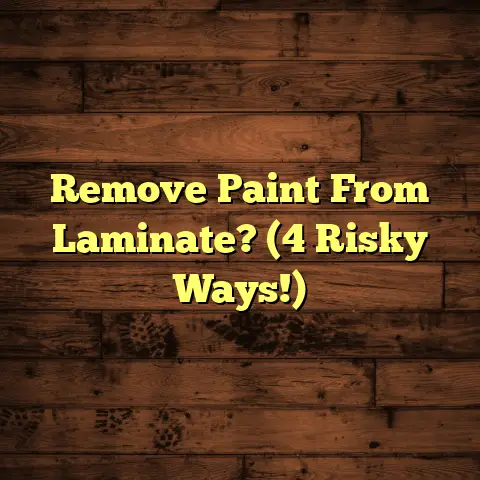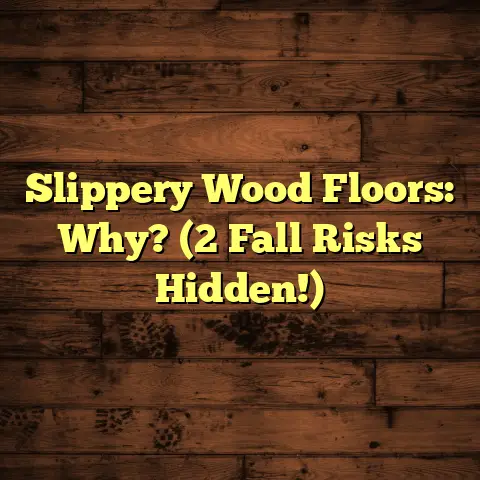Water Under Vinyl? (The #1 Mold Risk!)
One of the sneakiest and most common problems I encounter is water trapped under vinyl flooring.
It might seem harmless at first, but trust me, it’s a ticking time bomb for mold growth.
Let’s dive into the colorful world of vinyl flooring and uncover the dark secrets that can lurk beneath.
Section 1: Understanding Vinyl Flooring
1. What Is Vinyl Flooring?
Vinyl flooring is a synthetic flooring option made from PVC (polyvinyl chloride) and other compounds.
It’s known for its durability, water resistance, and relatively low cost, making it a popular choice for many homeowners.
There are several types of vinyl flooring:
Sheet Vinyl: This comes in large rolls and is typically installed as a single, seamless sheet.
It’s great for areas prone to moisture, like bathrooms and kitchens.Vinyl Tiles: These are individual tiles that can be arranged in various patterns.
They offer more design flexibility than sheet vinyl.Luxury Vinyl Plank (LVP): LVP mimics the look of hardwood or stone and comes in plank form.
It’s thicker and more durable than traditional vinyl and is a favorite for its realistic appearance.
2. Installation Process
The installation method plays a crucial role in preventing water issues.
Here’s a quick rundown:
Glue-Down: This method involves applying adhesive to the subfloor and then pressing the vinyl onto it.
Proper adhesion is key to preventing water from seeping in.Loose Lay: Loose lay vinyl is designed to stay in place without adhesive.
It’s easy to install but might not be the best choice for high-moisture areas.Click-Lock: Similar to laminate flooring, click-lock vinyl planks snap together.
This creates a floating floor that isn’t directly attached to the subfloor.
I always stress to my clients that proper installation is paramount.
Even the best vinyl flooring can fail if it’s not installed correctly.
Gaps, uneven surfaces, or poor adhesion can all lead to water accumulation.
3. Common Uses and Popularity
Vinyl flooring is a workhorse! You’ll find it everywhere:
- Residential Spaces: Kitchens, bathrooms, basements, and laundry rooms are prime candidates for vinyl flooring.
- Commercial Spaces: Hospitals, schools, and retail stores often use vinyl due to its durability and ease of maintenance.
Vinyl’s popularity is also driven by its versatility in design.
You can find vinyl flooring that mimics wood, stone, tile, and even abstract patterns.
The trends are constantly evolving, with LVP being a major player due to its realistic appearance and durability.
Section 2: The Hidden Dangers of Water Under Vinyl
1. Sources of Water Accumulation
Now, let’s get to the heart of the matter: how does water end up under your vinyl flooring?
Here are some common culprits:
-
Leaks: Plumbing leaks from sinks, toilets, or appliances can seep under the flooring.
Spills: Accidents happen!
Spilled water, if not cleaned up promptly, can find its way under the vinyl, especially if there are gaps or imperfections.-
Humidity: High humidity levels, particularly in basements or poorly ventilated areas, can lead to condensation under the flooring.
-
Subfloor Conditions: A damp or uneven subfloor can trap moisture and create a breeding ground for mold.
I’ve seen cases where a small, unnoticed leak under a sink led to extensive mold damage because the homeowner didn’t realize water was accumulating under the vinyl.
2. Signs of Water Damage
Catching water damage early can save you a lot of headaches.
Here are some telltale signs to watch out for:
-
Bubbles: Bubbles or blisters in the vinyl are a clear indication that water is trapped underneath.
-
Warping: The flooring may start to warp or buckle, especially near the edges or seams.
-
Discoloration: Water damage can cause discoloration or staining on the surface of the vinyl.
-
Musty Odor: A persistent musty smell is a strong sign of mold growth.
-
Soft Spots: Areas of the floor may feel soft or spongy when you walk on them.
Early detection is crucial.
The sooner you identify a problem, the easier it will be to fix it and prevent mold from taking hold.
3. The Mold Connection
Here’s the scary part: water + vinyl = mold risk.
Mold thrives in moist, dark environments, and the space under vinyl flooring provides the perfect conditions.
- Moisture: Water is essential for mold growth.
- Warm Temperatures: Mold loves warm, humid environments.
- Organic Material: The subfloor, adhesive, and even dust and dirt can provide the organic material mold needs to feed on.
According to the EPA, mold can start growing within 24-48 hours of water damage.
In fact, a study by the American Society of Microbiology found that certain types of mold can grow on vinyl flooring itself, using it as a food source.
Section 3: The Health Risks Associated with Mold
1. Understanding Mold
Mold is a type of fungus that reproduces by releasing spores into the air.
These spores are everywhere, both indoors and outdoors.
However, when mold spores land on a damp surface and find the right conditions, they can start to grow and form colonies.
Some common types of mold found in homes include:
- Aspergillus
- Cladosporium
- Penicillium
- Stachybotrys chartarum (black mold)
Mold spreads by releasing more spores, which can then travel through the air and contaminate other areas of your home.
2. Health Implications
Exposure to mold can cause a range of health problems, including:
- Respiratory Issues: Coughing, wheezing, shortness of breath, and asthma attacks.
- Allergies: Sneezing, runny nose, itchy eyes, and skin rashes.
- Irritation: Mold can irritate the eyes, nose, throat, and skin.
- Infections: In some cases, mold can cause serious infections, especially in people with weakened immune systems.
I remember one client who had persistent respiratory problems for months.
After investigating, we found a hidden mold colony under their vinyl flooring.
Once the mold was removed, their symptoms improved dramatically.
3. Vulnerable Populations
Certain groups are more susceptible to the health effects of mold exposure:
- Children: Children’s immune systems are still developing, making them more vulnerable to mold-related illnesses.
- Elderly: Older adults may have weakened immune systems or pre-existing respiratory conditions that make them more susceptible to mold.
- Immunocompromised Individuals: People with weakened immune systems due to illness or medical treatment are at higher risk of developing serious mold infections.
- People with Allergies/Asthma: These individuals may experience more severe allergic reactions or asthma attacks when exposed to mold.
If you or someone in your family falls into one of these categories, it’s especially important to be vigilant about preventing and addressing water damage.
Section 4: Prevention and Mitigation Strategies
1. Preventing Water Issues
The best way to deal with water under vinyl is to prevent it from happening in the first place.
Here are some proactive measures you can take:
- Proper Sealing: Seal around sinks, toilets, and other fixtures to prevent water from seeping under the flooring.
- Humidity Control: Use dehumidifiers in basements and other damp areas to keep humidity levels below 60%.
- Regular Maintenance: Inspect your plumbing regularly for leaks and address them promptly.
- Ventilation: Ensure adequate ventilation in bathrooms and kitchens to prevent moisture buildup.
- Choose the Right Flooring: Select vinyl flooring that is appropriate for the intended use and environment.
For example, sheet vinyl is a better choice for bathrooms than LVP with many seams.
I always advise my clients to invest in a good quality moisture meter.
It’s a small price to pay for the peace of mind it provides.
2. Immediate Actions Upon Detection
If you discover water under your vinyl flooring, act quickly:
- Remove the Source of Water: Stop the leak or clean up the spill immediately.
- Remove the Vinyl: Carefully remove the affected vinyl flooring, if possible.
- Dry Out the Area: Use fans and dehumidifiers to thoroughly dry the subfloor and surrounding areas.
- Assess the Damage: Check for signs of mold growth and structural damage.
- Call in Professionals: If the damage is extensive or you suspect mold, contact a professional mold remediation company.
Don’t try to tackle a large-scale mold problem on your own.
It’s best left to the experts who have the right equipment and training.
3. Long-term Solutions
Once the water damage has been addressed, consider these long-term solutions:
- Replace Damaged Flooring: Replace any vinyl flooring that has been damaged by water or mold.
- Repair the Subfloor: Repair or replace any damaged subfloor.
- Install a Moisture Barrier: Consider installing a moisture barrier under the new flooring to prevent future problems.
- Improve Ventilation: Improve ventilation in the affected area to reduce humidity levels.
- Regular Inspections: Continue to inspect your flooring regularly for signs of water damage.
Section 5: Case Studies and Real-Life Examples
1. Homeowner Experiences
I’ve seen countless cases of homeowners dealing with water and mold under their vinyl flooring.
Here’s one that stands out:
Sarah, a young homeowner, noticed a musty smell in her bathroom.
She initially dismissed it, but the smell persisted.
Eventually, she noticed some discoloration on the vinyl flooring near the toilet.
Upon closer inspection, she discovered that the toilet was leaking, and water had been seeping under the vinyl for weeks.
The subfloor was covered in mold, and the damage was extensive.
Sarah had to hire a mold remediation company to remove the mold and replace the subfloor and vinyl flooring.
The experience was costly and stressful, but she learned a valuable lesson about the importance of regular maintenance and prompt action.
2. Expert Opinions
I spoke with Mark, a certified mold remediation specialist, about the risks of water under vinyl flooring.
He emphasized that “the key is to address water issues quickly.
Mold can grow rapidly, and the longer you wait, the more extensive and costly the remediation will be.”
He also noted that “many homeowners underestimate the importance of proper ventilation.
Good ventilation can help prevent moisture buildup and reduce the risk of mold growth.”
Another common misconception, according to Mark, is that “all mold is toxic.
While some types of mold are more harmful than others, any mold growth should be addressed to protect your health.”
Conclusion: The Importance of Awareness
Water under vinyl flooring is a serious issue that can lead to mold growth and health problems.
By understanding the risks, taking proactive measures to prevent water damage, and acting quickly when problems arise, you can protect your home and your health.
Don’t wait until you smell that musty odor or see those telltale bubbles.
Inspect your flooring regularly, address any leaks promptly, and prioritize maintenance.
Your health and home are worth it!
And as your friendly neighborhood flooring contractor, I’m here to help you every step of the way.





